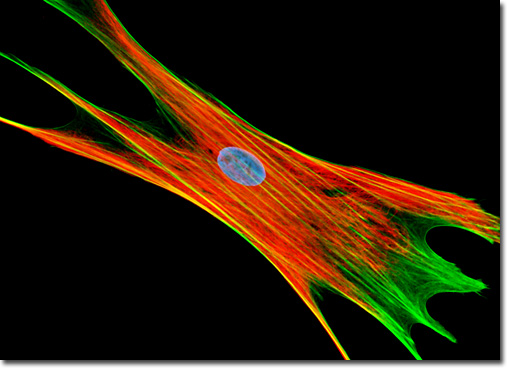Fluorescence Digital Image Gallery
Mongoose Skin Fibroblast Cells (APM)
|
Vimentin is an intermediate filament protein (58 kiloDaltons) that is generally found in a variety of cells of mesenchymal origin and is developmentally regulated. Unlike most other proteins that comprise intermediate filaments, vimentin is expressed during the initial stages of cellular development, but is typically substituted with other tissue-specific intermediate filament proteins later in the developmental process. Vimentin has proven useful in the differential detection of undifferentiated neoplasms and is thought be involved in the communication and transport between the surface of a cell and its nucleus. An entire family of intermediate filaments, usually termed vimentin-like or, more simply, vimentin filaments, are named after the polypeptide. Vimentin-like intermediate filaments may also be composed of other proteins, however, such as desmin, peripherin, and glial fibrillary acidic protein (GFAP), which are closely homologous to vimentin. In order to label the intermediate filaments in the log phase adherent African water mongoose culture illustrated above, the fixed and permeabilized cells were blocked and treated with mouse anti-vimentin (porcine eye lens) primary antibodies followed by goat anti-mouse secondary antibodies (IgG) conjugated to Texas Red-X. Filamentous actin was visualized with phalloidin conjugated to Oregon Green 488, while the nuclei were stained with Hoechst 33258. Images were recorded in grayscale with a QImaging Retiga Fast-EXi camera system coupled to an Olympus BX-51 microscope equipped with bandpass emission fluorescence filter optical blocks provided by Omega Optical. During the processing stage, individual image channels were pseudocolored with RGB values corresponding to each of the fluorophore emission spectral profiles. |
© 1995-2025 by Michael W. Davidson and The Florida State University. All Rights Reserved. No images, graphics, software, scripts, or applets may be reproduced or used in any manner without permission from the copyright holders. Use of this website means you agree to all of the Legal Terms and Conditions set forth by the owners.
This website is maintained by our
|
